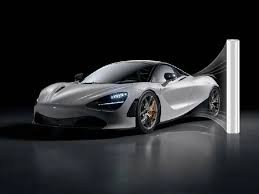How to Apply Paint Protection Film (PPF) to Your Car A Step-by-Step Guide
Applying Paint Protection Film (PPF) is one of the greatest ways to safeguard the significant investment that cars represent. The paint of your automobile is protected from scratches, stone chips, and other little damage by this transparent, long-lasting coating of film. PPF keeps your car looking like new whether you're driving in the city or on a long trip. PPF can be installed by specialists, but with the correct equipment and perseverance, it is possible to do it yourself. You will learn how to apply PPF step-by-step from this guide.
If you're in Abu Dhabi and prefer professional help, paint protection film in Abu Dhabi are available for those who want a flawless finish.
Let’s dive in and learn how you can protect your car’s paint yourself!
What Is Paint Protection Film?
But before moving into the steps, let's first understand what Paint Protection Film is. PPF is a thin, flexible, and transparent film made from urethane. When put onto a car's surface, it forms a layer in between your car's paint and outside elements, including debris, road salt, and bug splatter. The film is supposed to absorb the impact of those minor abrasions and not allow them to reach the paint.
PPF applied is almost invisible and leaves no change in the looks of your car. The application can range from full-vehicle application to a specific high-impact area application, for example, hood, front bumper, and side mirrors.
What You Will Need
Before you start, make sure you have the necessary tools and materials. Here's a list of things you'll need:
-
Paint Protection Film (pre-cut for your car model or in a roll)
-
Spray bottle with water and soap solution (mild dish soap works fine)
-
Squeegee (to remove air bubbles)
-
Alcohol-based cleaner (to prep the surface)
-
Microfiber towels
-
Sharp blade or cutter (for trimming)
-
Heat gun or hair dryer (to help stretch and conform the film)
Once you have everything ready, you can start applying the film. Remember, patience is key, and taking your time will lead to a much better result.
Step 1: Clean the Car’s Surface
First of all, clean the areas of PPF thoroughly. Any speck of dust, dirt, or debris left on the surface will be trapped under the film and ruin the finish. Wipe the entire surface with an alcohol-based cleaner and a microfiber cloth.
Make sure the car is parked inside in a clean, dust-free atmosphere. The cleaner the atmospheric conditions, the better one's results will be: be sure to pay extensive attention to the edges or corners, as they harbor the usual sites for an accumulation of dirt.
Step 2: Prepare the PPF and the Soapy Water Solution
Now, in a spray bottle, mix your soapy water solution. The soap allows the film to slide on the surface and enables you to position it correctly before it actually sticks.
If you have precut PPF for your model, then it is as easy as peeling the backing off and ready to go. If a roll of film is used, cut into pieces to fit the sections of the car desired for coverage.
Step 3: Spray the Surface with Soapy Water
Spray a liberal amount of the soapy water solution onto the car's surface where the PPF will go, including the adhesive side of the PPF. This prevents the film from sticking instantly and allows you some leeway in adjusting its position.
It is necessary to spray enough solution to avoid air bubbles and wrinkles in the application. It also serves to let the film slide into its place with ease.
Step 4: Apply the Film to the Car
Gently lay the PPF onto the car's surface. If you have sprayed enough soapy water, you should be able to slide the film around until it is perfectly aligned with the edges and curves of the car. If it doesn't look right, simply lift it off, spray more solution, and try again.
Just think of trying to do tiny sections, like the hood or a bumper, until it becomes easier to attempt much larger panels.
Step 5: Remove Air Bubbles and Excess Water
Once the film is in the correct position, use a squeegee to push out the air bubbles and excess water. Start from the center of the film and work your way toward the edges. Take your time and be gentle to avoid wrinkles.
Be sure to press firmly but not too hard, as this could damage the film. If you notice any bubbles, gently lift the film, spray more solution, and reapply.
Step 6: Heat the Film to Conform to Curves
Most cars have curved areas like bumpers, fenders, and mirrors that can be tricky to cover. This is where a heat gun or hair dryer comes in handy. Applying a bit of heat to the film helps it stretch and conform to the car’s curves more easily.
Hold the heat gun at a safe distance and gently warm up the film. Be careful not to overheat it, as this could cause the film to warp or shrink. Use the squeegee to press the film down as you apply heat.
Step 7: Trim Excess Film
Once the film is fully applied, trim any excess film along the edges using a sharp blade or cutter. Be careful not to cut too close to the paint, and always use a steady hand.
Some areas may require precise cutting, especially around door handles, mirrors, and emblems. Take your time and ensure the film fits snugly without overhanging edges.
Step 8: Let It Dry
After you've applied and trimmed the film, give it some time to dry. Avoid driving the car or exposing it to extreme weather conditions for at least 24 hours. This allows the film to fully bond to the car’s surface.
Over the next few days, you may notice small air bubbles that didn’t get squeezed out. Don’t worry; these will usually disappear as the film settles and the moisture evaporates.
Step 9: Regular Maintenance
To keep your PPF looking good and working effectively, regular maintenance is essential. Wash your car regularly with a mild soap solution and avoid abrasive cleaning products that could damage the film. If you notice any scratches or scuffs on the film, don’t panic! Many PPFs have self-healing properties and can repair minor scratches when exposed to heat or sunlight.
For a perfect finish or if you're unsure about DIY installation, Exotic Car Care offers professional PPF application services for those who want expert care.
Conclusion
Applying Paint Protection Film (PPF) may seem like a challenging task, but with the right tools and patience, it’s possible to do it yourself. From cleaning the surface to trimming the edges, each step is crucial to ensure a smooth, bubble-free finish. PPF not only keeps your car looking shiny and new but also protects it from daily wear and tear.







![Top Reasons To Have SEO Plan For Every Dubai Business [2025 Update]](/thumnails/blog/2024/11/1732278589.jpg)











